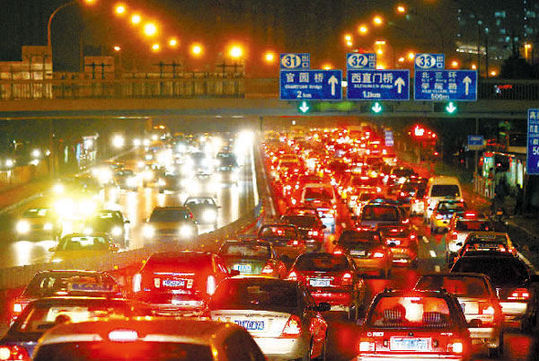'City disease' plagues big cities
What level of happiness can be achieved through vast urban life? Nowadays, social issues such as traffic congestion, pollution, healthcare access and cost affect more and more urban residents in big cities like Beijing, Shanghai and Guangzhou.
 |
|
?Traffic jams on the second ring road, Beijing. |
Some have grouped these problems together and labeled them an "urban disease," which refers to a series of social problems caused by a large increase of population into already crowded and stressed cities.
Beijing, Shanghai, Guangzhou and other big cities have become highly developed and full of resources, but many residents there don't feel happy or comfortable, and attribute their dissatisfaction to "urban disease," with its symptoms becoming more and more prevalent throughout China.
In July, the Beijing Municipal Committee of the Chinese People's Political Consultative Conference (CPPCC), a political advisory body, put forward a proposal concerning balanced development between the city's population growth and its resources and environmental health. According to the proposal, by the end of 2009 the population of Beijing had reached 19.72 million.
The rapidly growing population has brought various pressures to Beijing. It's been calculated that one person goes outdoors 2.64 times a day. Although public transport has developed rapidly in recent years, it's still not enough, which has led more people to choose to commute in their own vehicles. Back in May 2007, the number of motor vehicles reached 3 million, and by 2015 it's expected to exceed 7 million.
In 2009, 418,000 children of migrant workers were educated in Beijing, accounting for 40 percent of the total number of students.
In addition, the pressures on resources and the environment are getting more prominent. According to research, 98 percent of Beijing's energy is imported. The city's annual average available water supply is only 2.6 billion cubic meters, but the actual amount used is about 3.6 billion cubic meters. The exceeding amount relies on the excess consumption of reservoir storage, the over-draft of groundwater, and use of emergency water resources.
The rapid population expansion exists not only in Beijing. In 2009, Shanghai's resident population reached 19.21 million and 14 million for Guangzhou. Many social problems have been exacerbated by rapid population expansion.
At present, China appears to be at the peak of urbanization. According to the data released by the Chinese Academy of Social Sciences, the urbanization rate was 46.6 percent in 2009, lower than the world's average rate. However, in the future, many more cities will become big cities, and likely, without preventative measures, problems such as traffic congestion, water scarcity, pollution, and housing shortages are inevitably.
Professor Wang Yukai with the Chinese Academy of Governance said, "The maximal population capacity of Beijing is about 18 million, but now the actual number is already surpassed this limit. In this condition, urban disease is inevitable."
Wang believes the reason why rapid economic growth does not bring a comfortable life is complex, but cites flawed urban-development strategy, irrational industrial layout, unbalanced infrastructure, excessive pursuit of GDP and delayed social security. Because urban and rural areas have not integrated naturally, the resources cannot flow freely, and the gap between these two areas is growing.
According to Xu Zongwei, an expert on municipal utilities, urban disease shows that the dominant ideology of urban construction has gone wrong. Because of not knowing whom the city was built for, managers are driven by narrow criteria instead of public living satisfaction. Subsequently, houses become larger, bike paths become narrower, and the public facilities become more expensive.
"Cities have two basic functions; one is economic function, and the other is a living function," Xu said. If the economic side gets overemphasized the living function will be ignored or receive too little attention and inadequate funding. The purpose of economic development is to improve living conditions, but too much emphasis on economic growth affects the standard of living.
Wang believes that in the past 30 years China has paid too much attention to the development of some big cities, and now it's imperative to speed up the economy and social construction in mid-sized and small cities. For example, transfer labor-intensive industries to mid-sized or small cities, improve the threshold of registered enterprises, and re-adjust industrial layout.
Moreover, the adjustment of the city's evaluation index system is also necessary. "The United Nations has a set of index system for urban evaluation, many of which is about living quality. But our current evaluation index system still focuses on GDP," Wang said and added that government and city managers need a long-term perspective, modern management concepts and an accurate evaluation index system.
 0
0 






